The Bowes Museum Blog

Cleaning Fusiliers Medals

The Abbott’s Tower, Alnwick Castle. Home of the Fusiliers Museum [image courtesy of https://www.northumberlandfusiliers.org.uk]

Staff and volunteers cleaning medals at the Fusiliers Museum
For a previous display,the medals had been mounted onto black felt. Felt has been commonly used as a display fabric in the past, but with a better understanding of materials, and how they interact with museum objects, it is now no longer suitable. Felt is manufactured using sulphur, which can damage objects as it ‘off-gases’. This sulphur combines with the silver in the medal, forming silver sulphide – the brown tarnish you often see on silver objects.

Old display: medals mounted onto a felt display board
Silver sulphide is a more stable compound than sulphur, and when sulphur is in the presence of silver it will always combine to form silver sulphide. Eradication of sulphur-emitting textiles is a must when displaying silver to minimise tarnishing, and therefore future cleaning.

Before Cleaning (right), and After Cleaning (left)
Every time you clean silver, you remove a very thin layer of silver from the surface – so minimising cleaning helps safeguard the longevity of an item. You will often see on silver-plated objects where the object has been over-cleaned, the underlying base metal becomes visible.

Example of over-cleaning: a silver-plated candlestick, with the base metal now showing
While removing the medals from their previous display, I noticed that the plastic labels (which state the owner of the medals) smelt like vinegar. This is a sign that the plastic is deteriorating. The labels are made from cellulose acetate, an early semi-synthetic plastic. Deterioration, accelerated by ultra-violet light, and humidity above 40% causes the plastic to break down into it’s component parts – cellulose, and acetic (ethanoic) acid, with the accompanying smell.

Cellulose acetate name tag
Although the medals have been stored in a tower at the castle with small windows, the silk ribbons have received enough light to cause significant fading. This is irreversible damage.

Detail of silk ribbon, showing original colour (left), and fading (right)
The medals will be back on show when the Fusiliers Museum re-opens on March 27th 2016.
The Conservation Advisory Network (CAN) is delivered and managed through a partnership between The Bowes Museum and Tyne & Wear Archives & Museums (TWAM), funded through Arts Council England‘s Museum Development Programme and Major Partner Museum funding.
Karen Barker, Regional Conservator







